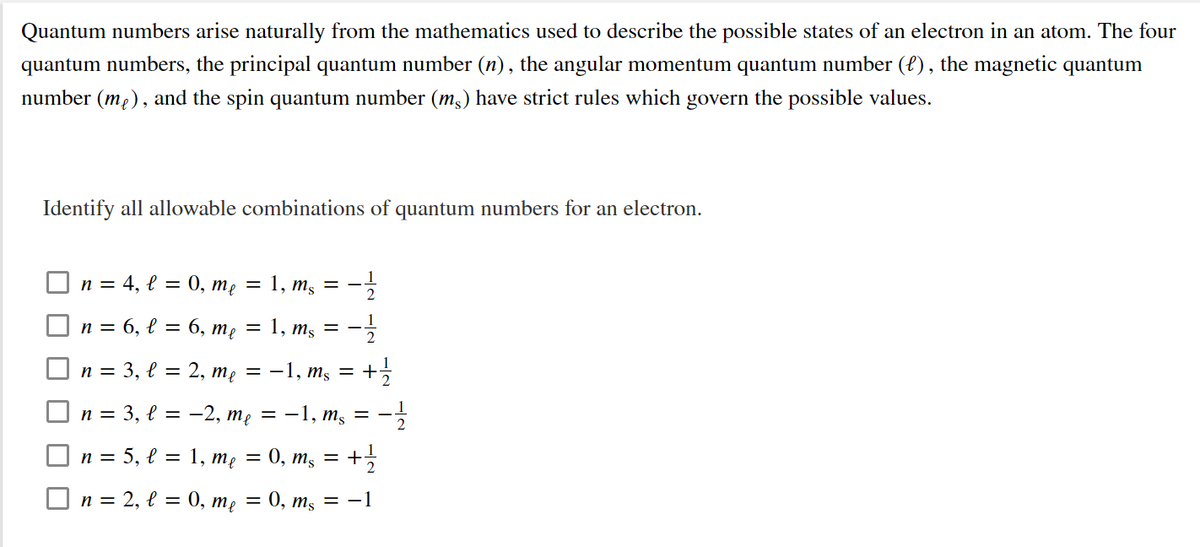Quantum numbers arise naturally from the mathematics used to describe the possible states of an electron in an atom. The four uantum numbers, the principal quantum number (n), the angular momentum quantum number (£), the magnetic quantum umber (mp), and the spin quantum number (m,) have strict rules which govern the possible values. Identify all allowable combinations of quantum numbers for an electron. n = 4, l = 0, me = 1, m, = - n = 6, l = 6, mẹ = 1, m, = - n = 3, l = 2, mẹ = -1, m, = + n = 3, l = -2, mẹ = -1, m, = - n = 5, l = 1, mẹ = 0, m, = + O n = 2, € = 0, mẹ = 0, m, = -1
Quantum numbers arise naturally from the mathematics used to describe the possible states of an electron in an atom. The four uantum numbers, the principal quantum number (n), the angular momentum quantum number (£), the magnetic quantum umber (mp), and the spin quantum number (m,) have strict rules which govern the possible values. Identify all allowable combinations of quantum numbers for an electron. n = 4, l = 0, me = 1, m, = - n = 6, l = 6, mẹ = 1, m, = - n = 3, l = 2, mẹ = -1, m, = + n = 3, l = -2, mẹ = -1, m, = - n = 5, l = 1, mẹ = 0, m, = + O n = 2, € = 0, mẹ = 0, m, = -1
Chemistry: Principles and Practice
3rd Edition
ISBN:9780534420123
Author:Daniel L. Reger, Scott R. Goode, David W. Ball, Edward Mercer
Publisher:Daniel L. Reger, Scott R. Goode, David W. Ball, Edward Mercer
Chapter7: Electronic Structure
Section: Chapter Questions
Problem 7.54QE
Related questions
Question

Transcribed Image Text:Quantum numbers arise naturally from the mathematics used to describe the possible states of an electron in an atom. The four
quantum numbers, the principal quantum number (n), the angular momentum quantum number ({), the magnetic quantum
number (mp), and the spin quantum number (m,) have strict rules which govern the possible values.
Identify all allowable combinations of quantum numbers for an electron.
n = 4, l = 0, me
= 1, m, = –
n = 6, l = 6, me
1, mş = -
п%3D 3, е %3D 2, те — — 1, m, — +
n = 3, l = -2, mẹ = -1, m,
= -
2
n = 5, l = 1, me = 0, m, = +
O n = 2, € = 0, mẹ = 0, mş = –1
Expert Solution
This question has been solved!
Explore an expertly crafted, step-by-step solution for a thorough understanding of key concepts.
Step by step
Solved in 2 steps with 2 images

Knowledge Booster
Learn more about
Need a deep-dive on the concept behind this application? Look no further. Learn more about this topic, chemistry and related others by exploring similar questions and additional content below.Recommended textbooks for you

Chemistry: Principles and Practice
Chemistry
ISBN:
9780534420123
Author:
Daniel L. Reger, Scott R. Goode, David W. Ball, Edward Mercer
Publisher:
Cengage Learning

Chemistry: The Molecular Science
Chemistry
ISBN:
9781285199047
Author:
John W. Moore, Conrad L. Stanitski
Publisher:
Cengage Learning

Chemistry: An Atoms First Approach
Chemistry
ISBN:
9781305079243
Author:
Steven S. Zumdahl, Susan A. Zumdahl
Publisher:
Cengage Learning

Chemistry: Principles and Practice
Chemistry
ISBN:
9780534420123
Author:
Daniel L. Reger, Scott R. Goode, David W. Ball, Edward Mercer
Publisher:
Cengage Learning

Chemistry: The Molecular Science
Chemistry
ISBN:
9781285199047
Author:
John W. Moore, Conrad L. Stanitski
Publisher:
Cengage Learning

Chemistry: An Atoms First Approach
Chemistry
ISBN:
9781305079243
Author:
Steven S. Zumdahl, Susan A. Zumdahl
Publisher:
Cengage Learning

Chemistry
Chemistry
ISBN:
9781305957404
Author:
Steven S. Zumdahl, Susan A. Zumdahl, Donald J. DeCoste
Publisher:
Cengage Learning


General Chemistry - Standalone book (MindTap Cour…
Chemistry
ISBN:
9781305580343
Author:
Steven D. Gammon, Ebbing, Darrell Ebbing, Steven D., Darrell; Gammon, Darrell Ebbing; Steven D. Gammon, Darrell D.; Gammon, Ebbing; Steven D. Gammon; Darrell
Publisher:
Cengage Learning